
Baptism is a Christian sacrament of initiation almost invariably with the use of water. It may be performed by sprinkling or pouring water on the head, or by immersing in water either partially or completely, traditionally three times, once for each person of the Trinity. The synoptic gospels recount that John the Baptist baptised Jesus. Baptism is considered a sacrament in most churches, and as an ordinance in others. Baptism according to the Trinitarian formula, which is done in most mainstream Christian denominations, is seen as being a basis for Christian ecumenism, the concept of unity amongst Christians. Baptism is also called christening, although some reserve the word "christening" for the baptism of infants. In certain Christian denominations, such as the Catholic Churches, Eastern Orthodox Churches, Oriental Orthodox Churches, Assyrian Church of the East, and Lutheran Churches, baptism is the door to church membership, with candidates taking baptismal vows. It has also given its name to the Baptist churches and denominations.
Pentecostalism or classical Pentecostalism is a Protestant Charismatic Christian movement that emphasizes direct personal experience of God through baptism with the Holy Spirit. The term Pentecostal is derived from Pentecost, an event that commemorates the descent of the Holy Spirit upon the Apostles and other followers of Jesus Christ while they were in Jerusalem celebrating the Feast of Weeks, as described in the Acts of the Apostles.
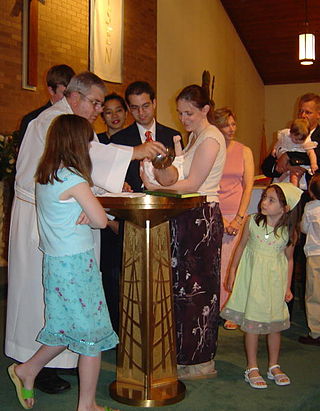
Infant baptism is the practice of baptizing infants or young children. Infant baptism is also called christening by some faith traditions.
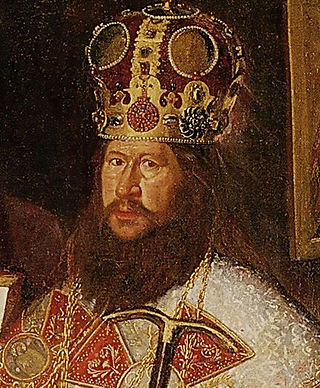
Nikon, born Nikita Minin was the seventh Patriarch of Moscow and all Rus' of the Russian Orthodox Church, serving officially from 1652 to 1666. He was renowned for his eloquence, energy, piety and close ties to Tsar Alexis of Russia. Nikon introduced many reforms, including liturgical reforms that were unpopular among conservatives. These divisions eventually led to a lasting schism known as Raskol (schism) in the Russian Orthodox Church. For many years, he was a dominant political figure, often equaling or even overshadowing the Tsar. In December 1667, Nikon was tried by a synod of church officials, deprived of all his sacerdotal functions, and reduced to the status of a simple monk.

Avvakum Petrov was a Russian Old Believer and protopope of the Kazan Cathedral on Red Square who led the opposition to Patriarch Nikon's reforms of the Russian Orthodox Church. His autobiography and letters to the tsar and other Old Believers such as Feodosia Morozova are considered masterpieces of 17th-century Russian literature.

Old Believers, also called Old Ritualists, are Eastern Orthodox Christians who maintain the liturgical and ritual practices of the Russian Orthodox Church as they were before the reforms of Patriarch Nikon of Moscow between 1652 and 1666. Resisting the accommodation of Russian piety to the contemporary forms of Greek Orthodox worship, these Christians were anathematized, together with their ritual, in a Synod of 1666–67, producing a division in Eastern Europe between the Old Believers and those who followed the state church in its condemnation of the Old Rite. Russian speakers refer to the schism itself as raskol (раскол), etymologically indicating a "cleaving-apart".
Oneness Pentecostalism is a nontrinitarian religious movement within the Protestant Christian family of churches known as Pentecostalism. It derives its name from its teaching on the Godhead, a form of Modalistic Monarchianism commonly referred to as the Oneness doctrine. The doctrine states that there is one God―a singular divine spirit with no distinction of persons―who manifests himself in many ways, including as Father, Son, and Holy Spirit. This stands in sharp contrast to the mainstream doctrine of three distinct, eternal persons posited by Trinitarian theology.
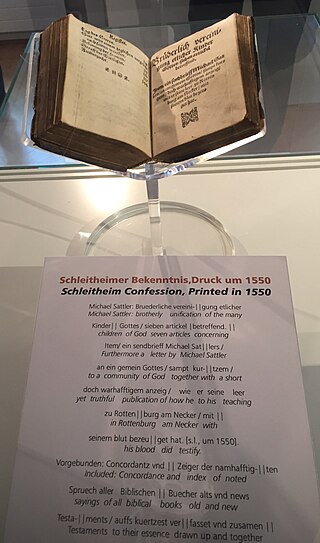
Anabaptist theology, also known as Anabaptist doctrine, is a theological tradition reflecting the doctrine of the Anabaptist Churches. The major branches of Anabaptist Christianity agree on core doctrines but have nuances in practice. While the adherence to doctrine is important in Anabaptist Christianity, living righteously is stressed to a greater degree.
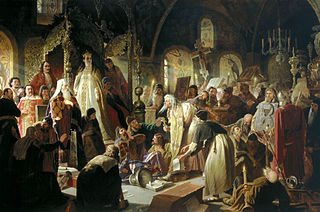
The Schism of the Russian Church, also known as Raskol, was the splitting of the Russian Orthodox Church into an official church and the Old Believers movement in the 1600s. It was triggered by the reforms of Patriarch Nikon in 1653, which aimed to establish uniformity between Greek and Russian church practices. In the 1630s and 1640s, Nikon had been a part of a group known as the Zealots of Piety, a circle of church reformers whose acts included amending service books in accordance with the "correct" Russian tradition. When Nikon became Patriarch of Moscow in 1652, he continued the practice of amending books under the guidance of Greek Orthodox advisors, changing practices in the Russian Church to align with the Greek rite. This act, along with the acceptance of the Nikonian reforms by Tsar Alexei Mikhailovich and the state, led to the rupture between Old Believers and the newly reformed church and state.
In Christian theology, baptism with the Holy Spirit, also called baptism in the Holy Spirit or baptism in the Holy Ghost, has been interpreted by different Christian denominations and traditions in a variety of ways due to differences in the doctrines of salvation and ecclesiology. It is frequently associated with incorporation into the Christian Church, the bestowal of spiritual gifts, and empowerment for Christian ministry. Spirit baptism has been variously defined as part of the sacraments of initiation into the church, as being synonymous with regeneration, or as being synonymous with Christian perfection. The term baptism with the Holy Spirit originates in the New Testament, and all Christian traditions accept it as a theological concept.
Peter of Bruys was a medieval French religious teacher. He was called a heresiarch by the Roman Catholic Church because he opposed infant baptism, the erecting of churches and the veneration of crosses, the doctrine of transubstantiation and prayers for the dead. An angry Roman Catholic mob murdered him in or around 1131.
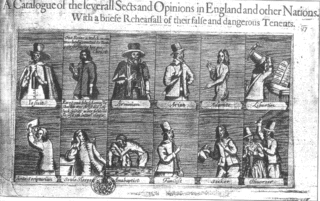
English Dissenters or English Separatists were Protestants who separated from the Church of England in the 17th and 18th centuries. English Dissenters opposed state interference in religious matters and founded their own churches, educational establishments and communities. They tended to see the established church as too Catholic, but did not agree on what should be done about it.
Mainstream Baptists is a network of Baptists in fourteen U.S. states that have organized to uphold historic Baptist principles, particularly separation of church and state, and to oppose Fundamentalism and Theocratic Calvinism within the Southern Baptist Convention. As such, it is not a denomination, but rather an organization that provides resources, support, and interagency communication. Organizations/agencies considered to share Mainstream Baptists and cooperate with and support the network are listed below under External links.

Orthodox Christianity is the most widely professed faith in Russia, with significant minorities of non-religious people and adherents of other faiths.

Apostasy in Christianity is the repudiation of Christ and the central teachings of Christianity by someone who formerly was a Christian (Christ-follower). The term apostasy comes from the Greek word apostasia meaning "rebellion", "state of apostasy", "abandonment", or "defection". It has been described as "a willful falling away from, or rebellion against, Christianity. Apostasy is the rejection of Christ by one who has been a Christian. …" "Apostasy is a theological category describing those who have voluntarily and consciously abandoned their faith in the God of the covenant, who manifests himself most completely in Jesus Christ." "Apostasy is the antonym of conversion; it is deconversion."

The Sinner's prayer is a Christian evangelical term referring to any prayer of repentance, prayed by individuals who feel sin in their lives and have the desire to form or renew a personal relationship. This prayer is not mandatory but, for some, functions as a way to communicate with and understand their relationship with God through Jesus Christ. It is a popular prayer in evangelical circles. While some Christians see reciting the Sinner's prayer as the moment defining one's salvation, others see it as a beginning step of one's lifelong faith journey.
Catholic spirituality includes the various ways in which Catholics live out their Baptismal promise through prayer and action. The primary prayer of all Catholics is the Eucharistic liturgy in which they celebrate and share their faith together, in accord with Jesus' instruction: "Do this in memory of me." The Catholic bishops at the Second Vatican Council decreed that "devotions should be so drawn up that they harmonize with the liturgical seasons, accord with the sacred liturgy, are in some fashion derived from it, and lead the people to it, since, in fact, the liturgy by its very nature far surpasses any of them." In accord with this, many additional forms of prayer have developed over the centuries as means of animating one's personal Christian life, at times in gatherings with others. Each of the religious orders and congregations of the Catholic church, as well as lay groupings, has specifics to its own spirituality – its way of approaching God in prayer to foster its way of living out the Gospel.
The Great Moscow Synod was a Pan-Orthodox synod convened by Tsar Alexis of Russia in Moscow in April 1666 in order to depose Patriarch Nikon of Moscow.

The Chasovennye people are a Siberian sect of the Old Believers, Eastern Orthodox Christians who reject the reforms of Patriarch Nikon of Moscow in the 1650s and retain pre-Nikonian religious practices. Although they once allowed priesthood, they eventually joined other priestless (Bezpopovtsy) movements and outlawed priesthood and sacraments beyond baptism. The term Chasovennye itself refers to the literal chapels in which liturgical practices such as baptism occurred.











